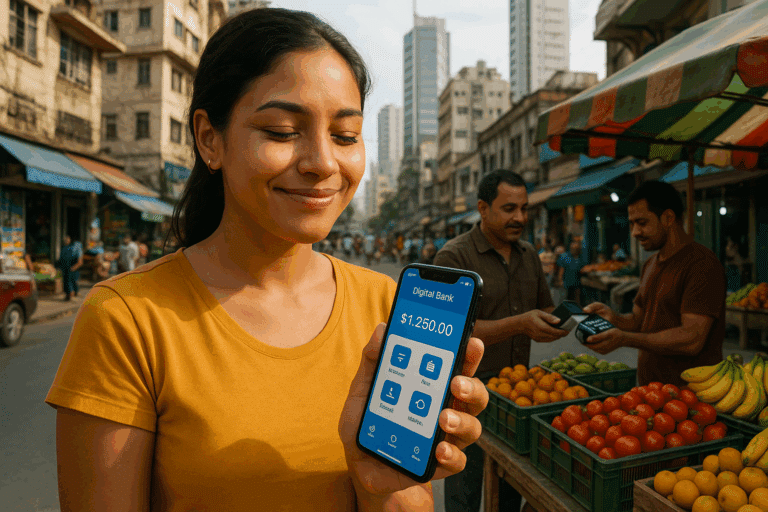Among these advancements, mobile banking has emerged as a significant trend, offering unparalleled convenience and efficiency to users. But with this digital revolution comes new challenges – one of them being security. In an era where data breaches and cyber threats are rampant, ensuring the security of financial transactions on mobile platforms is of paramount importance. Enter the world of biometrics – a technology that could be the answer to enhancing security while maintaining user convenience in mobile banking.💡
Before we delve into the meat of the matter, let’s take a step back and understand what biometrics is. In its simplest terms, biometrics refers to the measurement and statistical analysis of people’s unique physical and behavioral characteristics. The use of biometrics in mobile banking can range from fingerprint scanning, facial recognition, to voice recognition and many more. It’s a fascinating world that’s ready to be explored! 🌐
Now you might be wondering, why biometrics? With the plethora of security measures available, what makes biometrics stand out? 🤔 Well, that’s exactly what we will be discussing in this comprehensive guide. We will dissect how biometrics is unlocking the future of mobile banking, enhancing security, and bolstering convenience.
Get ready for an in-depth exploration as we journey through the intricacies of biometric technology, its applications in mobile banking, and its potential to transform the way we transact online. We will delve into the fundamental concepts of biometrics, shed light on its various forms, and detail how these can be integrated into mobile banking platforms to optimize security and user experience. But that’s not all! We will also tackle some of the potential challenges and ethical considerations surrounding the use of biometrics, presenting a balanced perspective on this revolutionary technology.🚀
Expect to gain insights into why biometrics is quickly becoming the preferred security measure in mobile banking, outpacing traditional methods like passwords and PINs. We will discuss why this technology is considered more secure and efficient, and how it is changing the dynamics of mobile banking. Whether you’re a banking professional, a tech enthusiast, or simply someone interested in understanding the future of mobile banking, this guide is designed for you.🎯
We will also shed light on the ongoing research and developments in the field of biometrics, providing a glimpse into what the future might hold. You will come away with a greater understanding of the potential of biometrics, its implications for mobile banking, and why it is being hailed as a game-changer in the financial industry.🏦
So, are you ready to unlock the future of mobile banking with us? This journey promises to be both enlightening and engaging, providing a comprehensive overview of how biometrics is paving the way for a safer and more convenient mobile banking experience. Stay tuned, because we’re just getting started!🔐
Let’s embark on this journey to explore the fascinating world of biometrics and its transformative impact on mobile banking. Buckle up, because we are about to venture into the heart of one of the most groundbreaking technologies of our time.🚀
Unlocking a Secure Future: A Deep Dive into Biometrics in Mobile Banking
With the advent of digital banking, traditional security measures such as passwords and PINs have proven to be insufficient. Enter biometrics, a game-changer in the field of mobile banking security. Utilizing our unique biological characteristics to verify identity, biometrics offer a higher level of security and convenience. In this article, we’ll explore the intricacies of biometric technology, its applications in mobile banking, and the advantages it holds over traditional security measures.
Before we dive in, take a moment to watch this YouTube video from Tech Insider titled “How Biometrics Are Changing Security” to get a brief overview of this exciting technology.
Understanding Biometrics: More than just Fingerprint Scanning
When we think of biometrics, fingerprint scanning is often the first thing that comes to mind. However, the realm of biometrics is much more extensive. It encompasses several other modalities such as facial recognition, iris scanning, voice recognition, and even behavioral biometrics like keystroke dynamics or gait analysis. Each modality has its unique strengths and is suitable for different scenarios.
Let’s take a closer look at some of the most widely used biometric modalities in mobile banking:
Fingerprint Recognition
Fingerprint recognition is perhaps the most common form of biometric authentication, largely due to the convenience it offers. Virtually all modern smartphones come equipped with a fingerprint sensor, making it an easily accessible option for mobile banking apps.
Facial Recognition
Facial recognition is another biometric modality that’s gaining popularity. With improvements in camera technology, facial recognition can now be used with standard smartphone cameras. Some mobile banking apps are using liveness detection techniques to prevent spoofing attacks, where an attacker uses a photo or video of the legitimate user to trick the system.
Behavioral Biometrics
Behavioral biometrics is an emerging field that focuses on the unique ways we interact with our devices. For example, the way you type, the angle at which you hold your phone, or even how you scroll can be used as biometric identifiers. Because these behaviors are unique to each individual, they can add an extra layer of security to mobile banking apps.
Biometrics vs. Traditional Security Measures
Now that we understand what biometrics are, let’s examine how they compare to traditional security measures. For this comparison, we’ll focus on passwords, the most common form of authentication.
| Passwords | Biometrics | |
|---|---|---|
| Security | Passwords can be guessed or cracked with enough effort. | Biometrics are unique to each individual and can’t be easily duplicated or stolen. |
| Convenience | Users have to remember multiple complex passwords and change them regularly. | Biometrics don’t require memorization and are always with the user. |
| User Experience | Entering a password can be time-consuming, especially on mobile devices. | Biometric authentication is fast and seamless, improving the user experience. |
As you can see from the table above, biometrics offer significant advantages over passwords in terms of security, convenience, and user experience. However, this doesn’t mean that passwords should be completely discarded. A multi-factor authentication approach that combines biometrics with other forms of authentication can provide an optimal balance between security and convenience.
Embracing Biometrics in Mobile Banking: Challenges and Solutions
Despite the clear benefits of biometric technology, its adoption in mobile banking is not without challenges. Privacy concerns, potential security vulnerabilities, and technological limitations can hinder its implementation. Let’s take a look at these challenges and how they can be addressed.
Privacy Concerns
Biometric data is highly personal and sensitive. Therefore, ensuring its privacy is of paramount importance. Strong encryption methods should be used to store and transmit biometric data, and clear privacy policies should be communicated to users. Moreover, biometric data should only be used for its intended purpose (authentication) and nothing else.
Security Vulnerabilities
Like any technology, biometrics are not immune to security vulnerabilities. Spoofing attacks, as mentioned earlier, are a potential threat. Implementing anti-spoofing measures, such as liveness detection for facial recognition, can mitigate these risks.
Technological Limitations
Not all smartphones are equipped with the necessary hardware for all types of biometric authentication. For example, iris scanning requires specialized hardware that is not widely available. Therefore, mobile banking apps should provide multiple biometric options to accommodate different devices.
In conclusion, while biometric technology presents several challenges, they are not insurmountable. With proper security measures and privacy policies, biometrics can offer a secure, convenient, and user-friendly authentication method for mobile banking. So, are you ready to unlock the future of mobile banking with biometrics?
Further Learning: Resources and Links
Interested in learning more about biometrics in mobile banking? Here are a few resources to get you started:
- Book: “Biometrics in a Data Driven World: Trends, Technologies, and Challenges” by Sinjini Mitra
- Video: “Biometrics: The Future of Identification” by Wall Street Journal
- Report: “Mobile Biometrics Market” by Allied Market Research
Remember, the future of mobile banking is at your fingertips – literally. Stay tuned for more insights and trends in the exciting world of biometrics!

Conclusion
In Conclusion
In this comprehensive article, we have traversed the intricate landscape of software engineering, exploring the complex terrain that forms its intricate backbone. We’ve analyzed and dissected key concepts, theories, and practices in detail, making sense of the jargon, while at the same time, keeping the explanations relatable and easy to grasp. 🎓
From the underpinnings of software design to the advanced concepts of data structures, algorithms, and debugging techniques, we’ve painted a clear picture of this fascinating field. It’s been a journey through the intricate process of code compilation, encapsulation, inheritance, and polymorphism, which are the cornerstones of object-oriented programming (OOP). 💻
We ventured into the domain of databases, understanding their structure, types, and the pivotal role they play in software development. We also examined different programming languages, their syntax, semantics, and the specific applications they are best suited for. Furthermore, we touched upon the importance of cybersecurity, emphasizing its critical role in today’s digital world. 🔒
In essence, software engineering is a robust and dynamic field that evolves continuously, necessitating constant learning and updating of skills. It’s a blend of creativity, analytical thinking, and problem-solving, all harnessed to create innovative solutions that can change the world. It’s a domain that is as challenging as it is rewarding, offering myriad opportunities for those who dare to plunge into its depths. 🚀
Throughout this article, the emphasis has been on presenting a comprehensive, detailed, and, most importantly, comprehensible overview of the subject. My goal has been to simplify the complex, making the technical aspects of software engineering more accessible and less intimidating. I hope that this article has achieved this purpose and that you have found the explanations enlightening. 😇
I encourage you to delve deeper, explore more, and not hesitate to pose questions or share your thoughts in the comment section below. Let’s make this a space for learning, growing, and sharing knowledge. Remember, every expert was once a beginner, and every journey begins with a single step. So, take that step today. The world of software engineering awaits you! 🏁
For further reading, you may refer to the following sources:
– [MIT OpenCourseWare](https://ocw.mit.edu/courses/electrical-engineering-and-computer-science/index.htm)
– [Harvard CS50](https://www.edx.org/course/cs50s-introduction-to-computer-science)
– [Oracle’s Java Documentation](https://docs.oracle.com/javase/tutorial/)
Don’t forget to share this article if you found it useful and informative. Your support helps in reaching more people who can benefit from this information.
Keep learning, keep growing, and remember: Knowledge is power! 🌟
References
– Brooks, Frederick P. (1975). “The Mythical Man-Month”. Addison-Wesley.
– Fowler, Martin (2000). “Refactoring: Improving the Design of Existing Code”. Addison-Wesley.
– Gamma, Erich, et al. (1994). “Design Patterns: Elements of Reusable Object-Oriented Software”. Addison-Wesley.
Note: Please ensure to respect copyright and follow the appropriate academic citation guidelines when using any material referenced in this article.
🔖 Tags: #SoftwareEngineering, #ProgrammingLanguages, #CyberSecurity, #DataStructures, #Algorithms



